Bad DC motor: Features and principle of operation. Bad DC ENGINEERS. Device of the Uncoolette Engine Engines Badzolettor Rounds
Household and medical facilities, aircodelling, pipe-air drives of gas and oil pipelines are far from a complete list of areas of use of unconnector engines (database) of DC. Let's look at the device and the principle of operation of these electromechanical drives in order to better understand their advantages and disadvantages.
General information, device, scope of application
One of the reasons for the manifestation of interest in the database is an increased need for high-speed micromotors with accurate positioning. Internally, the device of such drives is shown in Figure 2.
Fig. 2. Device of the uncoolette engineAs you can see, the design is a rotor (anchor) and a stator, on the first there is a permanent magnet (or several magnets located in a certain order), and the second is equipped with coils (B) to create a magnetic field.
It is noteworthy that these electromagnetic mechanisms can be both with an internal anchor (this type of construction can be seen in Figure 2) and external (see Fig. 3).
 Fig. 3. Design with external anchor (Outrunner)
Fig. 3. Design with external anchor (Outrunner) Accordingly, each of the designs has a certain scope of application. The internal anchor devices have a high rotational speed, therefore are used in cooling systems, as power plants of drones, etc. Drives with an external rotor are used wherever accurate positioning and resistance to overloads at the time (robotics, medical equipment, CNC machines, etc.).

Principle of operation
Unlike other drives, for example, an AC asynchronous machine, a special controller is needed for the database, which includes windings so that the vectors of magnetic anchors and stator fields are orthogonal to each other. That is, in fact, the driver device adjusts the torque acting by an anchor database. Visually this process is shown in Figure 4.

As you can see, for each armature movement, it is necessary to perform a certain switching in the winding of the stator of the engine of the uncoolette type. This principle of operation does not allow to smoothly manage rotation, but makes it possible to quickly gain momentum.
Differences of the collector and bulk engine
The collector-type drive differs from the database as constructive features (see Fig. 5.) and the principle of work.
 Fig. 5. A - collector engine, in - Bescalton
Fig. 5. A - collector engine, in - Bescalton Consider constructive differences. From Figure 5, it can be seen that the rotor (1 in Fig. 5) of the collector type motor, unlike the neckenet, has coils, in which the simple winding diagram, and permanent magnets (as a rule, two) are installed on the stator (2 in Fig. 5 ). In addition, the collector is installed on the shaft to which the brushes are connected supplying the anchor winding.
Briefly tell about the principle of work of collector machines. When voltage is supplied to one of the coils, it is excited, and a magnetic field is formed. It enters into interaction with permanent magnets, it makes itching anchor and the collector placed on it. As a result, the power is fed to another winding and the cycle is repeated.
The speed of rotation of the anchor of such a design directly depends on the intensity of the magnetic field, which, in turn, is directly proportional to the voltage. That is, to increase or decrease the turnover, it is enough to increase or reduce the power level. And for the reverse it is necessary to switch polarity. This method of management does not require a special controller, since the stroke control can be made on the basis of the variable resistor, and the usual switch will work as an inverter.
Constructive features of uncoolette type engines We were viewed in the previous section. As you remember, their connection requires a special controller, without which they simply will not work. For the same reason, these engines cannot be used as a generator.
It is also worth noting that in some drives of this type, the positions of the rotor are tracked for more efficient control using the Hall sensors. This significantly improves the characteristics of neclector engines, but leads to the rise in prices and so the uneven design.
How to run the uncoolette engine?
To force the drives of this type, the special controller will be required (see Fig. 6). Without it, the launch is impossible.
 Fig. 6. Controllers of bulk engines for models
Fig. 6. Controllers of bulk engines for models Collect the same device itself does not make sense, cheaper and more reliable will be purchased ready. You can choose it in the following characteristics inherent in PWM channel drivers:
- The maximum allowable strength of the current, this characteristic is given for the standard mode of operation of the device. Quite often, manufacturers indicate such a parameter in the model name (for example, Phoenix-18). In some cases, the peak mode is given, which the controller can support a few seconds.
- Maximum standard voltage for long work.
- Resistance to the internal chains of the controller.
- The permissible number of revolutions is indicated in RPM. Over this value, the controller will not increase the rotation (the limitation is implemented at the program level). It should be noted that the rotational speed is always given for bipolar drives. If pairs of poles are more, you should divide the value to their number. For example, the number 60000 RPM is indicated, therefore, for a 6-magnetic engine, the rotational speed will be 60000/3 \u003d 2000 PRM.
- The frequency of the generated pulses, in most controllers this parameter lies in the range from 7 to 8 kHz, more expensive models allow you to reprogram the parameter, increasing it to 16 or 32 kHz.
We note that the first three characteristics determine the power of the database.
Controlling the uncoolette engine
As mentioned above, the switching switching of the drive winding is carried out by electronics. To determine when switching, the driver tracks the position of the anchor using the Hall sensors. If the drive is not equipped with such detectors, then in the calculation is taken by the reverse EMF, which occurs in the unconnected coils of the stator. The controller, which, in fact, is a hardware and software package, tracks these changes and sets the switching order.
Three-phase Bad DC electric motor
Most databases are performed in three-phase execution. To control such a drive in the controller there is a constant voltage converter into a three-phase pulse (see Fig. 7).
 Figure 7. DB voltage diagrams
Figure 7. DB voltage diagrams To explain how such a valve engine works, it follows with Figure 7 to consider Figure 4, where all the steps of the actuator are shown alternately. Cut them:
- A positive impetus is served on the coil "A", while on "B" - negative, as a result, the anchor will move. The sensors will lock its movement and will be given a signal for the next switching.
- The coils "A" turns off, and the positive impulse goes to "C" ("B" remains unchanged), then the signal is fed to the next set of pulses.
- On "C" - positive, "A" - negative.
- There is a pair of "B" and "A" to which positive and negative impulses come.
- The positive impetus is re-fed to "B", and negative on "C".
- Coils "A" (served +) and a negative pulse is repeated on "C". Next, the cycle is repeated.
In the apparent ease of management there are a lot of difficulties. It is necessary not only to track the armature position to produce the following series of pulses, and also control the speed of rotation, adjusting the current in the coils. In addition, you should choose the most optimal parameters for overclocking and braking. It is also worth not to forget that the controller must be equipped with a block that allows you to manage it. The appearance of such a multifunctional device can be seen in Figure 8.
 Fig. 8. Multifunctional control controller controller
Fig. 8. Multifunctional control controller controller Advantages and disadvantages
The electric uncoolette engine has many advantages, namely:
- The service life is much longer than the usual collector analogues.
- High efficiency.
- Quick set of maximum speed of rotation.
- It is more powerful than KD.
- The absence of sparks during operation allows you to use the drive in fire hazardous conditions.
- No additional cooling required.
- Simple operation.
Now consider minuses. A significant disadvantage that limits the use of database is relatively high costs (including the price of the driver). The inconvenience should be attributed to the impossibility of using the database without a driver, even for short-term inclusion, for example, to check the performance. Problem repair, especially if rewind is required.
Engines are used in many areas of technology. In order to rotate the rotor of the engine, it is necessary to have a rotating magnetic field. In conventional DC motors, this rotation is carried out by mechanically using the brushes to the collector sliding. At the same time, sparking arises, and, in addition, due to friction and wear of brushes for such engines, constant maintenance is necessary.
Due to the development of the technique, it became possible to generate a rotating magnetic field electronically, which was embodied in DC neolotor motors (BDPT).
Device and principle of operation
The main elements of the BDPT are:
- rotoron which constant magnets are strengthened;
- statoron which windings are installed;
- electronic controller.
By design, such an engine can be of two types:
with the internal location of the Rotor (Inrunner)

with external rotor location (Outrunner)
In the first case, the rotor rotates inside the stator, and in the second - the rotor spins around the stator.
Engine type inrunner Used in the case when it is necessary to get large rotation revolutions. This engine has a simpler standard design that allows you to use a fixed stator for fastening the engine.
Engine type outrunner Suitable for greater torque at low speed. In this case, the engine mount is performed using a fixed axis.
Engine type inrunner - Large speed, low torque. Engine type outrunner - Little turns, high torque.
The number of poles in BDPT can be different. In terms of the number of poles, you can judge some of the engine characteristics. For example, the engine with a rotor having 2 poles has a greater number of revolutions and a small moment. Engines with an increased amount of poles have a larger point, but a smaller number of revolutions. By changing the number of rotor poles, you can change the number of engine speed. Thus, changing the engine design, the manufacturer may select the necessary engine parameters at the time and number of revolutions.
Management BDPT.

Roll control, appearance
For control of the bulk engine used special Controller - Engine Shaft Rotation Speed \u200b\u200bRegulator direct current. Its task is to generate and feed at the desired moment on the desired winding of the required voltage. In the controller for instruments with power supply 220, the inverter scheme is most often used, in which the current conversion with a frequency of 50 Hz is first in a constant current, and then to signals with pulse modulation (PWM). To supply the power supply voltage on the stator winding, powerful electronic keys on bipolar transistors or other power elements are used.
Adjusting the power and speed of the engine is carried out by changing the strength of pulses, and, therefore, the active value of the voltage supplied to the engine stator winding.

Roll control circuit diagram. K1-K6 - D1-D3 keys - Rotor position sensors (Hall sensors)
An important issue is the timely connection of electronic keys to each winding. To ensure this the controller must determine the position of the rotor and its speed. Optical or magnetic sensors can be used to obtain such information (for example, hall sensors), as well as inverse magnetic fields.
More common use hall sensorsthat react to the presence of a magnetic field. Sensors are placed on the stator in such a way that the magnetic field of the rotor acted on them. In some cases, sensors are installed in devices that allow you to change the position of the sensors and, accordingly, adjust the advance angle (Timing).
Rotor rotation regulators are very sensitive to the strength of the current passing through it. If you select a battery with a greater output current, then the regulator is burning! Correct the combinations of characteristics correctly!
Advantages and disadvantages
Compared to conventional BDPT engines have the following advantages:
- big CPD;
- high speed;
- the ability to change the frequency of rotation;
- lack of sparkling brushes;
- small noiseboth in sound and high-frequency bands;
- reliability;
- ability to resist overloads at the time;
- excellent the ratio of dimensions and power.
The baseball engine is distinguished by a large efficiency. It can reach 93-95%.
The high reliability of the mechanical part of the database is explained by the fact that it uses ball bearings and there are no brushes. The demagnetization of permanent magnets occurs quite slowly, especially if they are made using rare-earth elements. When used in the current protection controller, the service life of this node is quite high. Actually bDPT service life can be determined by the service life of ball bearings.
The disadvantages of the BDPT are the complexity of the management system and the high cost.
Application
The scope of BDTP is as follows:
- creating models;
- medicine;
- automotive;
- oil and gas industry;
- appliances;
- military equipment.
 Using DB for aircraft model Gives a significant advantage in power and dimensions. Comparison of the usual collector engine type SPEED-400 and the BDTP of the same class ASTRO FLIGHT 020 shows that the engine of the first type has an efficiency of 40-60%. The CPD of the second engine under the same conditions can reach 95%. Thus, the use of the database allows you to increase almost 2 times the power of the strength of the model or the time of its flight.
Using DB for aircraft model Gives a significant advantage in power and dimensions. Comparison of the usual collector engine type SPEED-400 and the BDTP of the same class ASTRO FLIGHT 020 shows that the engine of the first type has an efficiency of 40-60%. The CPD of the second engine under the same conditions can reach 95%. Thus, the use of the database allows you to increase almost 2 times the power of the strength of the model or the time of its flight.
Due to the small noise and the lack of heating when the BDPT work is widely used in medicine, especially in dentistry.
In cars, such engines are used in glass lifts, electric chowers, headlights and elevator elevators.
No collector and sparking brushes Allows you to use the database as the elements of shut-off devices in the oil and gas industry.
As an example of using databases in household appliances, a washing machine with a direct drive of the LG drum can be washed. This company uses the Outrunner BDTP. On the engine rotor, there are 12 magnets, and on the stator - 36 inductors coils that are wrapped with a wire with a diameter of 1 mm on cores from magnetically conductive steel. The coils are connected sequentially 12 pieces in the phase. The resistance of each phase is 12 ohms. A hall sensor is used as the rotor position sensor. The engine rotor is attached to the Baku of the washing machine.
 Everywhere this engine is used in hard drives for computers, which makes them compact, in CD and DVD drives and cooling systems for micro-electronic devices and not only.
Everywhere this engine is used in hard drives for computers, which makes them compact, in CD and DVD drives and cooling systems for micro-electronic devices and not only.
Along with the database of small and medium power in industry with heavy working conditions, ship and military industries are increasingly used by large BDPT.
Light power databases are designed for American Navy. For example, PowerTec has developed a 220 kW BDTP at a speed of 2000 rpm. The moment of the engine reaches 1080 nm.
In addition to these areas, the database is used in the projects of machines, presses, plastics processing lines, as well as in wind power and the use of tidal waves.
Characteristics
Main engine characteristics:
- rated power;
- maximum power;
- maximum current;
- maximum operating voltage;
- maximum revs (or KV coefficient);
- resistance to windings;
- angle of advance;
- operating mode;
- warning characteristics Engine.
The main indicator of the engine is its rated power, that is, the power generated by the engine for a long time of its operation.
 Maximum power - This is the power that the engine can give during a short-term period of time, not destroying. For example, for the ASTRO FLIGHT 020, the Astro Flight 020, which mentioned above, it is 250 W.
Maximum power - This is the power that the engine can give during a short-term period of time, not destroying. For example, for the ASTRO FLIGHT 020, the Astro Flight 020, which mentioned above, it is 250 W.
Maximum current. For Astro Flight 020, it is equal to 25 A.
Maximum operating voltage - Voltage that can withstand engine windings. For Astro Flight 020, operating voltages range from 6 to 12 V.
Maximum engine speed. Sometimes the passport indicates the KV coefficient - the number of engine speeds per volt. For Astro Flight 020 kv \u003d 2567 rev / c. In this case, the maximum number of revolutions can be determined by multiplying this coefficient to the maximum operating voltage.
Usually resistance to windings For engines is tenths or thousandths of Ohm. For Astro Flight 020 R \u003d 0.07 Ohm. This resistance affects the efficiency of BDPT.
Angle of advance It is ahead of switching voltages on windings. It is associated with the inductive nature of the resistance of the windings.
Mode of operation can be long or short-term. With long-term mode, the engine can work for a long time. At the same time, the heat allocated to them is completely dissipated and it does not overheat. In this mode, engines operate, for example, in fans, conveyors or escalators. Short-term mode is used for devices such as an elevator, an electric shaver. In these cases, the engine works a short time, and then cooled for a long time.
In the passport on the engine, its dimensions and weight are given. In addition, for example, for engines designed for aircraft models, landing dimensions and shaft diameter are given. In particular, the ASTRO FLIGHT 020 engine contains the following characteristics:
- length is 1.75 ";
- diameter is 0.98 ";
- the diameter of the shaft is 1/8 ";
- the weight is 2.5 oz.
Conclusions:
- In modeling, in various technical products, in industry and defense equipment used BDPT, in which the rotating magnetic field is formed by an electronic circuit.
- By its design, the BDPT can be with the internal (internal) and external (Outrunner) by the location of the rotor.
- Compared to other BDPT engines have several advantages, the main of which are the absence of brushes and sparking, large efficiency and high reliability.
Distinctive features:
- BCEPT General Information
- Uses the power cascade controller
- Sample program code
Introduction
This application guidelines are described in these application recommendations, how to implement a control unit for controlling the DC control motor (BKEPT) using a position sensor based on AVR microcontroller AT90PWM3.
The high-performance microcontroller AVR core, which contains a power cascade controller, allows you to implement a controller for controlling a high-speed DC controller motor.
This document provides a short description of the principle of operation of the uncoolette motor DC motor, and the Details considers the BCEPT control in touch mode, and the description of the ATAVRMC100 reference development schema is described, which is based on these appointment recommendations.
Also discussed software implementation with a software-implemented control circuit based on the PID controller. To control the switching process, the use of only position sensors based on the Hall effect is implied.
Operating principle
The scope of BKEPT continuously increases, which is associated with a number of their advantages:
- The absence of a collector node, which simplifies or even excludes maintenance.
- Generate a lower level of acoustic and electrical noise compared to universal DC collector engines.
- Ability to work in hazardous environments (with flammable products).
- Good ratio of bulb characteristics and power ...
Engines of this type are characterized by a small inertia of the rotor, because Winding are located on the stator. Switching is controlled by electronics. Moments of switching are defined either according to information from position sensors, or by measuring the reverse e.d., generated by windings.
When operating using BKEPT sensors, it is usually of the three main parts: a stator, a rotor and linel sensors.
The stator of the classic three-phase BKEPT contains three windings. In many engines, the windings are divided into several sections, which reduces the rolling moment pulsations.
Figure 1 shows the electrical stator substitution scheme. It consists of three windings, each of which contains three consecutive elements included: inductance, resistance and reverse E.D.S.
Figure 1. Electrical stator replacement scheme (three phases, three windings)
The BKEPT rotor consists of an even number of permanent magnets. The amount of magnetic poles in the rotor also affects the size of the rotation and rolling momentum steps. The greater the number of poles, the smaller the size of the rotation step and less rolling momentum. Permanent magnets can be used with 1..5 pairs of poles. In some cases, the number of pairs of poles increases to 8 (Figure 2).

Figure 2. Stator and rotor of three-phase, three-winding BKEPT
The windings are installed stationary, and the magnet rotates. The BKEPT rotor is characterized by a lighter weight relative to the rotor of an ordinary universal DC motor, which is located on the rotor.
Hall Sensor
To estimate the position of the rotor, three Hall sensors are embedded in the engine housing. Sensors are installed at an angle of 120 ° in relation to each other. Using sensor data it is possible to perform 6 different switches.
Switching phases depends on the state of the hall sensors.
The supply of supply voltages on the winding changes after changing the states of the Hall sensor outputs. With the correct execution of synchronized switching, the torque remains approximately constant and high.
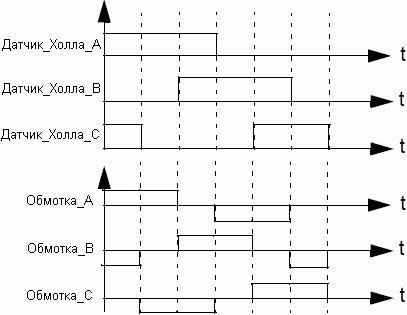
Figure 3. Hall sensor signals in the process of rotation
Switching phases
In order to simplify the description of the work of the three-phase BKEPT, we consider only its version with three windings. As previously shown, the switching phase depends on the output values \u200b\u200bof the Hall sensors. With the correct supply of voltage on the engine winding, a magnetic field is created and rotation is initiated. The most common and simple switching control method used to control the BCEPT is the turning on-shutdown scheme when the winding is either conducting current or not. At one point in time, only two windings can be seized, and the third remains disconnected. Connecting windings to power bus causes electric current. This method is called trapezoidal commutation or block switching.
A power cascade consisting of 3 half-liters is used to control BKEPT. The scheme of the power cascade is shown in Figure 4.

Figure 4. Power Cascade
According to the values \u200b\u200bof the Hall sensors, it is determined which keys must be closed.
Table 1. Switching the keys clockwise
In engines with several fields, electrical rotation does not correspond to mechanical rotation. For example, in four-polyvous BKEPT, four electrical rotation cycles correspond to one mechanical rotation.
The power and speed of the engine depends on the power of the magnetic field. You can adjust the speed of rotation and rotating the engine by changing the current through the winding. The most common way to control the current through the winding is the middle current. To do this, use latitude-pulse modulation (PWM), the operating cycle of which determines the average voltage value on the windings, and, therefore, the average current value and, as a result, the rotational speed. The speed can be adjusted at frequencies from 20 to 60 kHz.
The rotating field of three-phase, three-winding BKEPT is shown in Figure 5.
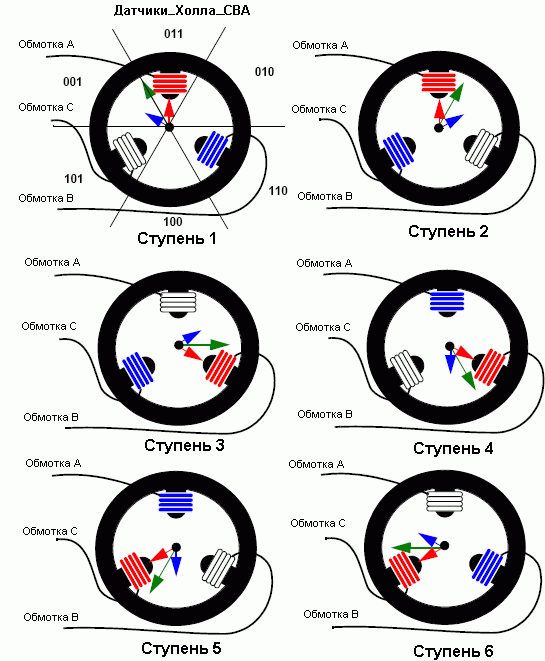
Figure 5. Switching steps and rotating field
The switching process creates a rotating field. On the stage 1 phase A, it connects to the positive feed bus of the SW1 key, the phase B is connected to a common with the SW4 key, and the phase C remains unconnected. Phases A and B are created two vector magnetic flux (shown in red and blue arrows, respectively), and the sum of these two vectors gives the vector of the magnetic stream of the stator (green arrow). After that, the rotor tries to follow the magnetic stream. As soon as the rotor reaches a certain position in which the state of the hall sensors is changed from the "010" value to "011", the switching of the engine windings is performed accordingly: the phase in remains uncasal, and the phase C is connected to the total. This leads to the generation of the new vector of the magnetic stream of the stator (stage 2).
If you follow the switching scheme shown in Figure 3 and in Table 1, we obtain six different magnetic flux vectors corresponding to six switching steps. Six steps correspond to one rotor turnover.
Starter set atavrmc100
The circuit diagram is presented in Figures 21, 22, 23 and 24 at the end of the document.
The program contains a speed control circuit with a PID controller. Such a regulator consists of three links, each of which is characterized by its own transmission ratio: KP, KI and KD.
KP is the transmission coefficient of the proportional link, Ki is the transmission coefficient of the integrating link and KD - the coefficient of transmission of the differentiating link. The deviation of the specified speed from the actual (in Figure 6 is called the "Missing" signal ") is processed by each of the links. The result of these operations is folded and fed to the engine to obtain the desired speed of rotation (see Figure 6).

Figure 6. Structural PID Regulator Scheme
The CP coefficient affects the duration of the transition process, the coefficient ki allows you to suppress static errors, and the CD is used, in particular, to stabilize the position (see the description of the control circuit in the software archive for changing coefficients).
Description of hardware
As shown in Figure 7, the microcontroller contains 3 power cascade controllers (PSC). Each PSC can be considered as a latitude-pulse modulator (PWM) with two output signals. To avoid the occurrence of through current, the PSC supports the ability to control the latency of the power of power keys (see the documentation for AT90PWM3 for a more detailed study of the PSC operation, as well as Figure 9).
Emergency input (over_current, current overload) is associated with PSCIN. Emergency input allows the microcontroller to disable all PSC outputs.

Figure 7. Hardware implementation
To measure the current, two differential channels with a programmable amplifier cascade can be used (ku \u003d 5, 10, 20 or 40). After selecting the gain coefficient, it is necessary to pick up the nominal sunting resistor for the most complete coverage of the conversion range.
The Over_Current signal is formed by an external comparator. The threshold voltage of the comparator can be adjusted using an internal DAC.
Switching the phases must be performed in accordance with the value at the outputs of the Hall sensors. DH_A, dh_b and dh_c are connected to the inputs of sources of external interrupts or to three internal comparators. Comparators generate the same type of interrupts as external interrupts. Figure 8 shows how the I / O ports are used in the starting set.

Figure 8. Using the microcontroller I / O ports (SO32 housing)
VMOT (VDV) and VMOT_HALF (1/2 VDV) are implemented, but not used. They can be used to obtain information about the power supply voltage.
Outputs H_x and L_X are used to control the power bridge. As mentioned above, they depend on the power cascade controller (PSC), which generates PWM signals. In this application, it is recommended to use control mode in the center (see Figure 9) when the OCR0RA register is used to synchronize the launch of the ADC transformation to measure the current.

Figure 9. Oscillograms of PSCN0 and PSCN1 signals in level alignment mode
- Time incl. 0 \u003d 2 * OcrNSA * 1 / FCLKPSC
- Time incl. 1 \u003d 2 * (OCRNRB - OCRNSB + 1) * 1 / FCLKPSC
- PSC \u003d 2 * (OCRNRB + 1) * 1 / FCLKPSC
Non-defense pause between PSCN0 and PSCN1:
- | OcrNSB - OcrNSA | * 1 / FCLKPSC
The PSC block is clocked by CLKPSC signals.
One of two methods can be used to feed the PWM signals in the power cascade. The first is the application of the PWM signals to the upper and lower parts of the power cascade, and the second - in the PWM signals application only to the upper parts.
Software description
Atmel has developed libraries to manage BKEPT. The first step of their use is the configuration and initialization of the microcontroller.
Configuration and initialization of the microcontroller
To do this, use the MC_INIT_MOTOR () function. It causes the function of initializing the hardware and software part, as well as initializes all engine parameters (direction of rotation, speed and stop motor).
Software structure structure
After the configuration and initialization of the microcontroller can be launched the engine. Only several functions are needed to control the engine. All functions are defined in MC_LIB.H:
Void MC_MOTOR_RUN (Void) - Used to start the engine. The stabilization circuit function is called to install the PWM working cycle. After that, the first switching phase is performed. BOOL MC_MOTOR_IS_RUNNING (Void) - Determining the engine status. If "1", the engine works if "0", the engine is stopped. Void MC_Motor_Stop (Void) - Used to stop the engine. Void MC_SET_MOTOR_SPEED (U8 SPEED) - installation of a user-defined speed. U8 MC_GET_MOTOR_SPEED (Void) - Returns the user specified speed. Void MC_SET_MOTOR_DIRECTION (U8 Direction) - setting the direction of rotation "CW" (clockwise) or "CCW" (counterclockwise). U8 MC_GET_MOTOR_DIRECTION (Void) - Returns the current direction of rotation of the engine. U8 MC_SET_MOTOR_MEASURED_SPEED (U8 Measured_Speed) - Saving the measured speed in the MEASURED_SPEED variable. U8 MC_GET_MOTOR_MEASURED_SPEED (Void) - Returns the measured speed. Void MC_SET_CLOSE_LOOP (Void) void MC_SET_OPEN_LOOP (Void) - configuration of the stabilization circuit: closed circuit or open (see Figure 13).
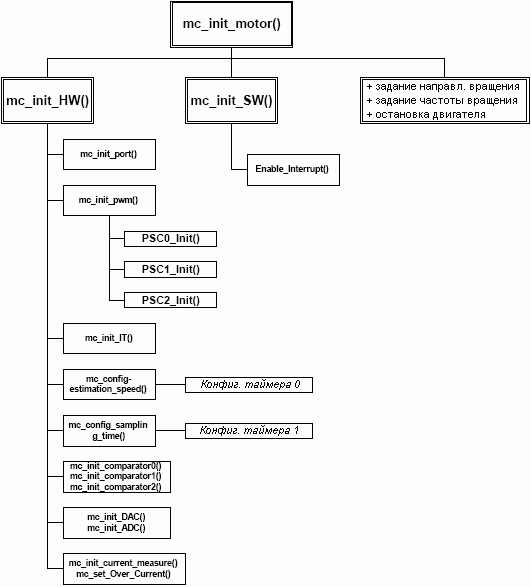
Figure 10. AT90PWM3 configuration
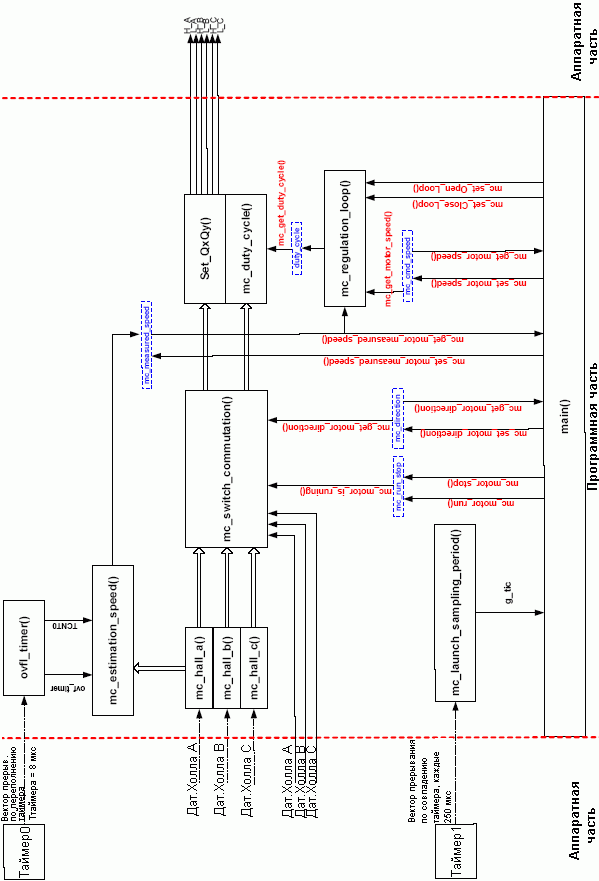
Figure 11. Software structure
Figure 11 shows four variables MC_RUN_STOP (START / STOP), MC_Direction (Direction), MC_CMD_SPEED (specified speed) and MC_MEASURD_SPEED (measured speed). They are the main software variables, access to which can be performed by the previously described user functions.
Software implementation can be viewed as a black box with the name "Engine Management" (Figure 12) and multiple inputs (MC_RUN_STOP, MC_Direction, MC_CMD_SPEED, MC_MEASURD_SPEED) and outputs (all power bridge control signals).

Figure 12. Basic software variables
Most features are available in MC_DRV.H. Only some of them depend on the type of engine. Functions can be divided into four main classes:
- Initialization of the hardware void mc_init_hw (void); The initialization of the hardware is fully implemented in this function. Here are initialized ports, interrupts, timers and controllers of the power cascade.
- Switching functions U8 MC_GET_HALL (Void); Reading the state of the hall sensors corresponding to six switching steps (HS_001, HS_010, HS_011, HS_100, HS_101, HS_110).
Interrupt void MC_HALL_A (Void); _Interrupt void mc_hall_b (void); _Interrupt void mc_hall_c (void); These functions are executed if the external interruption is detected (changing the output of the Hall sensors). They allow you to switch the phases and calculate the speed.
Void MC_DUTY_CYCLE (U8 LEVEL); This function sets the operating cycle of PWM in accordance with the PSC configuration.
Void MC_SWITCH_COMMUTIATION (U8 Position); The switching of the phases is performed in accordance with the value at the outputs of the Hall sensors and only if the user starts the engine.
- Configuration of the Time Conversion Void MC_CONFIG_SAMPLING_PERIOD (Void); Timer 1 initialization for interrupt generation every 250 μs. _interrupt void launch_sampling_period (void); After activating 250 μL interrupts sets the flag. It can be used to control the conversion time.
- Void valuation Void MC_CONFIG_TIME_ESTIMATION_SPEED (Void); Configuration Timer 0 To perform the speed calculation function.
Void MC_ESTIMATION_SPEED (Void); This function calculates the engine speed based on the principle of measuring the period of the liner sensor pulses.
Interrupt void OVFL_TIMER (Void); If an interrupt occurs, an increment of an 8-bit variable is incremented for implementing a 16-bit timer using an 8-bit timer.
- Current measurement _interrupt void ADC_EOC (Void); The ADC_EOC function is performed immediately after converting the amplifier to install the flag that the user can be used.
Void MC_INIT_CURRENT_MEASURE (Void); This feature initializes amplifier 1 for current measurement.
U8 MC_GET_CURRENT (Void); Read current value if the conversion is complete.
BOOL MC_CONVERSION_IS_FINISHED (Void); Indicates conversion completion.
Void mc_ack_eoc (void); Reset the conversion completion flag.
- Detection of current overloading Void MC_SET_OVER_CURRENT (U8 LEVEL); Sets the threshold for determining the current overload. As a threshold, there is an exit of the DAC associated with the external comparator.
Void mc_init_sw (void); Used to initialize software. Allows all interrupts.
Void MC_INIT_PORT (Void); Initialization of the I / O port by setting through the DDRX registers, which conclusions function as an input, and which output, as well as indicating which inputs it is necessary to enable pull-up resistors (through the portx register).
Void mc_init_pwm (void); This feature starts the PLG and sets all PSC registers to its original state.
Void mc_init_it (void); Modify this feature to resolve or prohibit interrupt types.
Void PSC0_INIT (Unsigned int DT0, unsigned int ot0, unsigned int dt1, unsigned int ot1); Void PSC1_INIT (unsigned int dt0, unsigned int ot0, unsigned int dt1, unsigned int ot1); Void PSC2_INIT (unsigned int dt0, unsigned int ot0, unsigned int dt1, unsigned int ot1); PSCX_INIT allows the user to select the configuration of the power cascade controller (PSC) of the microcontroller.
The stabilization circuit is selected using two functions: open (MC_SET_OPEN_LOOP ()) or closed circuit (MC_SET_CLOSE_LOOP ()). Figure 13 shows a software-implemented stabilization circuit.

Figure 13. Stabilization circuit
A closed circuit is a circuit of stabilization of the PID-regulator-based speed.
As shown earlier, the KP coefficient is used to stabilize the engine response time. At first, set the ki and kD equal to 0. To obtain the desired engine response time, you must select the value of the KP.
- If the response time is too small, then increase the CP.
- If the response time is fast, but not stable, then reduce the CP.

Figure 14. Setting up KP
The ki parameter is used to suppress the static error. Leave the CP coefficient unchanged and set the ki parameter.
- If the error differs from zero, then increase the ki.
- If the suppression of the error was preceded by an oscillatory process, then reduce the ki.
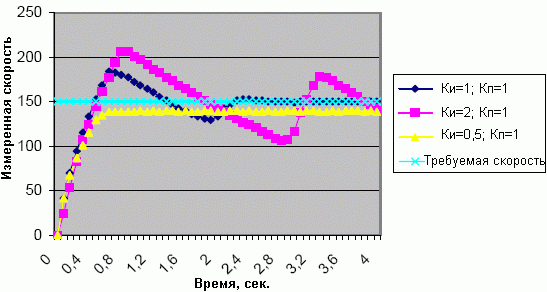
Figure 15. Custom
Figures 14 and 15 shows examples of selecting the correct parameters of the KP regulator \u003d 1, ki \u003d 0.5 and kd \u003d 0.
Setting the CD parameter:
- If the speed is low, then increase the CD.
- With instability of the CD, it is necessary to reduce.
Another essential parameter is the conversion time. It must be chosen regarding the system reacting time. The conversion time must be at least two times less than the response time of the system (according to the Cotelnikov rule).
To configure the conversion time, two functions are provided (discussed above).
Their result is displayed in the G_Tick global variable, which is installed every 250 μs. With this variable it is possible to configure the conversion time.
CPU and memory usage
All measurements are performed at a generator frequency of 8 MHz. They also depend on the type of engine (number of pairs of poles). When using the engine with 5 pairs of poles, the signal frequency at the output of the Hall sensor is 5 times lower than the engine speed.
All the results shown in Figure 16 were obtained using a three-phase BKEPT with five pairs of poles and the maximum rotation frequency of 14000 rpm.

Figure 16. Using the speed of the microcontroller
In the worst case, the microcontroller load level is about 18% with a transformation time of 80 ms and the rotational speed of 14000 rpm.
The first estimate can be performed for a faster engine and with the addition of the current stabilization function. The execution time of the MC_REGulation_loop () function is between 45 and 55msc (it is necessary to take into account the TSP conversion time of about 7 μs). A BCEPT was selected for the assessment with a current response time of about 2-3 ms, five pairs of poles and the maximum rotation frequency of about 2-3 ms.
The maximum engine speed is about 50,000 rpm. If the rotor uses 5 pairs of poles, the resulting frequency at the outlet of the Hall sensors will be equal to (50,000 rpm / 60) * 5 \u003d 4167 Hz. The MC_ESTIMATION_SPEED () function starts with each increasing front of the Hall sensor A, i.e. Every 240 ISS with the duration of the execution of 31 μs.
The MC_SWITCH_COMMUTIATION () function depends on the operation of the Hall sensors. It is performed when the fronts occur at the output of one of the three Hall sensors (increasing or falling front), thus, in one period of pulses at the output of the Hall sensor, six interrupts are generated, and the resulting frequency of the function call is 240/6 μs \u003d 40 μs.
Finally, the conversion time of the stabilization circuit should be at least two times less than the engine response time (about 1 ms).
The results are shown in Figure 17.

Figure 17. Assessment of the loading of the microcontroller
In this case, the level of loading the microcontroller is about 61%.
All measurements were performed using the same software. Communication resources are not used (WAPP, LIN ...).
Under such conditions, the following memory capacity is used:
- 3175 program memory bytes (38.7% of the total flash memory).
- 285 data memory bytes (55.7% of the total volume of static RAM).
Configuration and use of atavrmc100
Figure 18 presents a complete diagram of various operating modes of the ATAVRMC100 starting set.
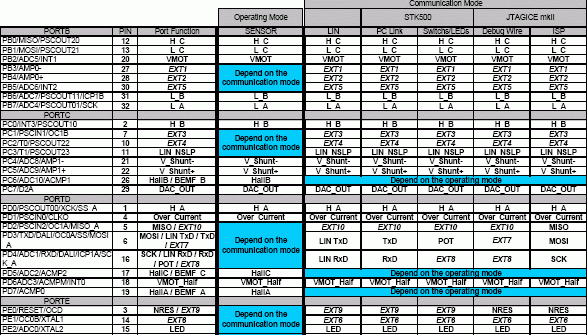
Figure 18. Purpose of the I / O ports of the microcontroller and communication modes
Operating mode
Two different modes of operation are supported. Set jumpers JP1, JP2 and JP3 in accordance with Figure 19 to select one of these modes. In these application guidelines, only mode using sensors is used. A full description of the hardware is provided in the user manual for the ATAVRMC100 set.

Figure 19. Select control mode using sensors
Figure 19 shows the source settings of the jumpers that comply with the use of software associated with these application guidelines.
The program that comes with the ATAVRMC100 board supports two modes of operation:
- running the engine at maximum speed without external components.
- adjusting the engine speed using one external potentiometer.
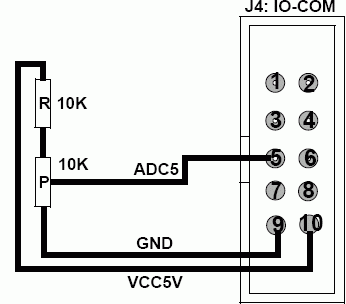
Figure 20. Potentiometer connection
Conclusion
In these recommendations for use, a hardware and software solution for controlling the control unit of the DC is presented using sensors. In addition to this document, the full source code is available for download.
The program library includes starting and controlling the speed of any BCEPT with built-in sensors.
The schematic diagram contains a minimum of external components necessary for control of BKEPT with built-in sensors.
The capabilities of the CPU and the memory of the AT90PWM3 microcontroller will allow the developer to expand the functional solution.

Figure 21. Concept electrical circuit (part 1)
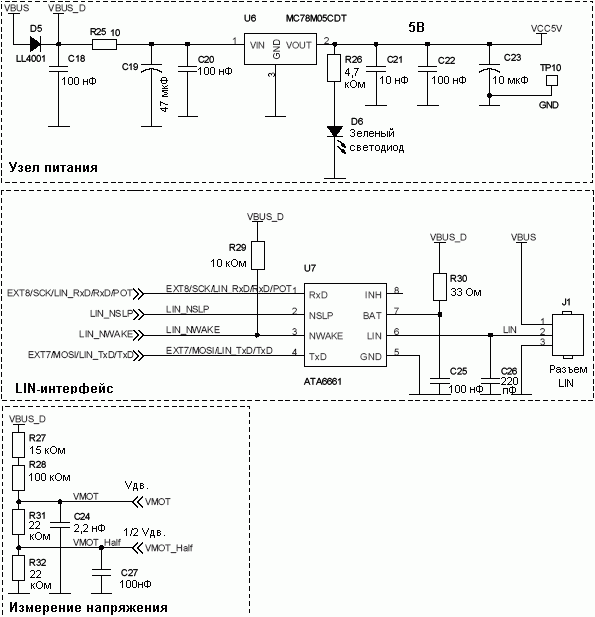
Figure 22. Concept electrical diagram (part 2)

Figure 23. Concept electrical circuit (part 3)
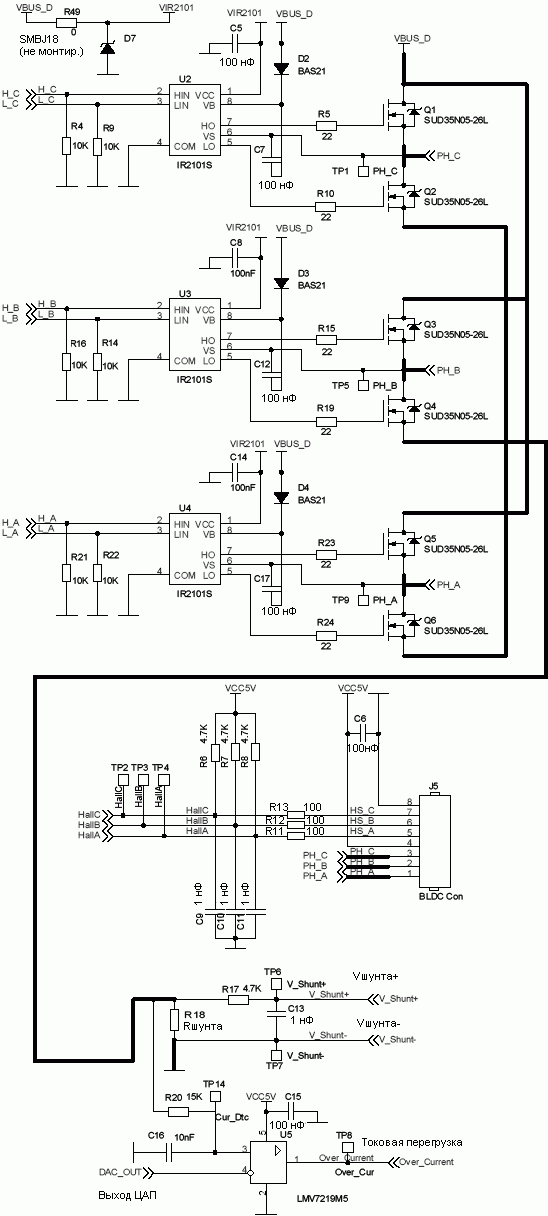
Figure 24. Concept electrical diagram (part 4)
Documentation:
Fantastic renovation of apartments and repair cottages for big money.
Some of the history:
The main problem of all engines is overheating. The rotor rotated inside a stator, and therefore it did not go away from overheating. People occurred in the head a brilliant idea: not the rotor rotate, but the stator, which, when rotated, would be cooled with air. When such an engine was created, it began to be widely used in aviation and shipbuilding, and therefore it was nicknamed by a valve engine. 
Soon the electrical analogue of the valve engine was created. Called it with a neclector motor, because he did not have collectors (brushes). 
Bescolettor (Brushless English) Electric motors came to us relatively recently, in the last 10-15 years old. Unlike collector motors, they feed on a three-phase alternating current. Bulk engines work effectively in a wider range of revolutions and have more high efficiency. The design of the engine is relatively simpler, there is no brush node in it, which constantly rubs with the rotor and creates sparks. It can be said that the brushless motors are practically not wearing. The cost of bulk engines is slightly higher than collective. This is due to the fact that all the brushless motors are equipped with bearings and, as a rule, manufactured better.



Tests showed:
Thrust with screw 8x6 \u003d 754 grams,
Rotation frequency \u003d. 11550 rpm,
Power consumption \u003d 9 watt(without screw) , 101 watt(with screw),

Power and efficiency
Power can be calculated in this way:
1) Power in mechanics is calculated by such a formula: N \u003d f * vwhere F is power, and V is speed. But since, the screw is in a static state, then there is no movement, except for rotational. If this motor is installed onto the aircodel, then the speed could be measured (it is 12 m / s) and calculate useful power:
N Ul \u003d 7.54 * 12 \u003d 90.48 watts
2) Electric engine efficiency is at such a formula: Efficiency \u003d n useful / n spent * 100%where N costs \u003d 101 watts
KPD \u003d 90.48 / 101 * 100% \u003d 90%
On average, the efficiency of undercoltor engines really and fluctuates about 90% (the largest efficiency achieved by this type of motors is equal to 99.68%
)
Engine characteristics:
Voltage: 11.1 Volt.
Turns: 11550 rpm
Maximum current: 15A.
Power: 200 watt
Traction: 754 grams (screw 8x6)

Conclusion:
The price of any thing depends on the scale of its production. Manufacturers of bulk motors multiply like mushrooms after the rain. Therefore, I want to believe that in the near future, the price of controllers and uniform engines will fall, as it fell on the equipment of radio control ... The capabilities of microelectronics every day are all expanding, the size and weight of controllers gradually decrease. It can be assumed that in the near future the controllers will begin to embed directly into the engines! Maybe we will live to this day ...










